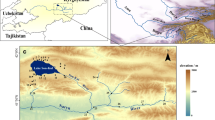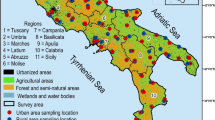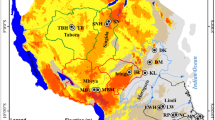Abstract
Being the third polar region of the earth, the Qinghai-Tibet Plateau (QTP) has a significant impact on the whole earth, especially on the Eurasian environment and ecosystem, making it crucial to understand the environmental changes occurring in the area. However, the exploitation and utilization of mineral resources are affecting the ecosphere of QTP, especially in the farming-pastoral ecotone. More research needs to be conducted on the distribution and sources of persistent organic pollutants in this region. To address this research gap, this study investigates the characteristics of organochlorine pesticides (OCPs) in Ganhe industrial parks (GDIP), located in a farming-pastoral ecotone and the surrounding soils. The study analyzed 22 soil samples collected from two intersections. The findings revealed that hexachlorocyclohexanes (HCHs) and dichlorodiphenyltrichloroethanes (DDTs) were the dominant components of the 15 OCPs, accounting for more than 75% of the total OCPs among sampling sites. These compounds had high mean concentrations of up to 2506.3 and 152.7 μg kg−1, respectively. High levels of OCPs were observed in the southeastern and southern regions of GDIP. Agricultural soils were more susceptible to OCP pollution due to frequent agricultural activities compared to grassland. Source apportionment analysis showed that OCPs in the area might primarily comprise lindane (detected in 54.5% of the samples) and dicofol (detected in 86.4% of the samples), implying that these two OCPs could still be in use in this area. Therefore, further investigation into the use and pollution of OCPs in the farming-pastoral ecotone in the northeast of QTP is necessary, and their impact on the ecosystem needs to be evaluated.



Similar content being viewed by others
Data Availability
All data generated or analyzed during this study are included in this published article.
References
Chen, Y. P., Zhao, Y., Zhao, M. M., Wu, J. H., & Wang, K. B. (2021). Potential health risk assessment of HFRs, PCBs, and OCPs in the Yellow River basin[J]. Environmental Pollution, 275(1), 116648. https://doi.org/10.1016/j.envpol.2021.116648
Daly, G. L., Lei, Y. D., Teixeira, C., Muir, D. C., & Wania, F. (2007). Pesticides in western Canadian mountain air and soil[J]. Environmental Science and Technology, 41(17), 6020–6025. https://doi.org/10.1021/es070848o
Ding, Y., Li, L., Wania, F., Huang, H. F., Zhang, Y., Peng, B., Chen, Y. J., & Qi, S. H. (2021). Do dissipation and transformation of γ -HCH and p, p’ -DDT in soil respond to a proxy for climate change? Insights from a field study on the eastern Tibetan Plateau[J]. Environmental Pollution, 278, 116824. https://doi.org/10.1016/j.envpol.2021.116824
Feng, J. L., Zhai, M. X., Liu, Q., Sun, J. H., & Guo, J. J. (2011). Residues of organochlorine pesticides (OCPs) in upper reach of the Huaihe River, East China[J]. Ecotoxicology and Environmental Safety, 74, 2252–2259. https://doi.org/10.1016/j.ecoenv.2011.08.001
Fu, L., Lu, X. B., Tan, J., Zhang, H. J., Zhang, Y. C., Wang, S. Q., & Chen, J. P. (2018). Bioaccumulation and human health risks of OCPs and PCBs in freshwater products of Northeast China[J]. Environmental Pollution, 242(Pt B), 1527–1534. https://doi.org/10.1016/j.envpol.2018.08.046
Fu, S., Chu, S., & Xu, X. (2001). Organochlorine pesticide residue in soils from Tibet, China[J]. Bulletin of Environment Contamination and Toxicology, 66(2), 171–177. https://doi.org/10.1007/s0012800221
Geng, C. Y., Koga, M., & Shinohara, R. (2012). Survey and evaluation of organochlorine pesticides in human serum from Huangzhong county, Qinghai province[J]. Journal of Qinghai Medical College, 33(2), 137–142. https://doi.org/10.3969/j.issn.1006-8252.2012.02.017
Huang, H. F., Ding, Y., Chen, W., Zhang, Y., Chen, W. W., Chen, Y. J., Mao, Y., & Qi, S. H. (2019). Two-way long-range atmospheric transport of organochlorine pesticides (OCPs) between the Yellow River source and the Sichuan Basin, Western China[J]. Science of the Total Environment, 651, 3230–3240. https://doi.org/10.1016/j.scitotenv.2018.10.133
Huang, H. F., Liu, H. F., Xiong, S., Zeng, F. M., Bu, J. W., Zhang, B., Liu, W., Zhou, H., Qi, S. H., Xu, L., & Chen, W. (2021). Rapid transport of organochlorine pesticides (OCPs) in multimedia environment from karst area[J]. Science of the Total Environment, 775, 145698. https://doi.org/10.1016/j.scitotenv.2021.145698
Li, Y. F. (1999). Global technical hexachlorocyclohexane usage and its contamination consequences in environment: From 1948 to 1997[J]. Science of the Total Environment, 232, 123–160. https://doi.org/10.1016/S0048-9697(99)00114-X
Li, Z. H., Wang, W., Ji, Y. P., Li, W., Han, Y. X., Xu, J. T., Sheng, Y. Q., Shi, Z., & Zhu, L. Z. (2021). A super typhoon disturbs organic contamination in agricultural soils[J]. Environmental Science and Technology Letters, 8(3), 237–243. https://doi.org/10.1021/acs.estlett.0c00963
Ma, Y., Yun, X. T., Ruan, Z. Y., Lu, C. J., Shi, Y., Qin, Q., Men, Z. M., Zou, D. Z., Du, X. M., Xing, B. S., & Xie, Y. F. (2020). Review of hexachlorocyclohexane (HCH) and dichlorodiphenyltrichloroethane (DDT) contamination in Chinese soils [J]. Science of the Total Environment, 749, 141212. https://doi.org/10.1016/j.scitotenv.2020.141212
Macdonald, R. W. (2005). Climate change, risks and contaminants: A perspective from studying the Arctic[J]. Human and Ecological Risk Assessment, 11, 1099–1104. https://doi.org/10.1080/10807030500346482
Meijer, S. N., Ockenden, W. A., Sweetman, A., Breivik, K., Grimalt, J. O., & Jones, K. C. (2003). Global distribution and budget of PCBs and HCB in background surfacesoils: Implications or sources and environmental processes[J]. Environmental Science and Technology, 37, 667–672. https://doi.org/10.1021/es025809l
Metcalf, R. L. (1973). Century of DDT[J]. Journal of Agriculture and Food Chemistry, 21, 511–519. https://doi.org/10.1021/jf60188a040
Niu, L. L., Xu, C., Zhu, S. Y., & Liu, W. P. (2016). Residue patterns of currently, historically and never-used organochlorine pesticides in agricultural soils across China and associated health risks[J]. Environmental Pollution, 219, 315–322. https://doi.org/10.1016/j.envpol.2016.10.060
Peng, J. Y., Chen, Y. N., Xia, Q., Rong, G. Z., & Zhang, J. Q. (2021). Ecological risk and early warning of soil compound pollutants (HMs, PAHs, PCBs and OCPs) in an industrial city, Changchun, China[J]. Environmental Pollution, 272, 116038. https://doi.org/10.1016/j.envpol.2020.116038
Qadeer, A., Liu, S., Liu, M., Liu, X. R., Ajmal, Z., Huang, Y. P., Jing, Y., Khalil, S. K., Zhao, D. D., Du, M. N., Wei, X. Y., & Liu, Y. K. (2019). Historically linked residues profile of OCPs and PCBs in surface sediments of typical urban river networks, Shanghai: Ecotoxicological state and sources[J]. Journal of Cleaner Production, 231, 1070–1078. https://doi.org/10.1016/j.jclepro.2019.05.203
Qiu, X. H., & Zhu, T. (2010). Using the o, p’-DDT/ p, p’-DDT ratio to identify DDT sources in China[J]. Chemosphere, 81(8), 1033–1038. https://doi.org/10.1016/j.chemosphere.2010.08.049
Qu, C. K., Albanese, S., Chen, W., Lima, A., Doherty, A. L., Piccolo, A., Arienzo, M., Qi, S. H., & De Vivo, B. (2016). The status of organochlorine pesticide contamination in the soils of the Campanian Plain, southern Italy, and correlations with soil properties and cancer risk[J]. Environmental Pollution, 216, 500–511. https://doi.org/10.1016/j.envpol.2016.05.089
Qu, C. K., Albanese, S., Li, J. J., Cicchella, D., Zuzolo, D., Hope, D., Cerino, P., Pizzolante, A., Doherty, A. L., Lima, A., & De Vivo, B. (2019). Organochlorine pesticides in the soils from Benevento provincial territory, southern Italy: Spatial distribution, air-soil exchange, and implications for environmental health[J]. Science of the Total Environment, 674, 159–170. https://doi.org/10.1016/j.scitotenv.2019.04.029
Qu, C. K., Xing, X. L., Albanese, S., Doherty, A. L., Huang, H. F., Lima, A., Qi, S. H., & De Vivo, B. (2015). Spatial and seasonal variations of atmospheric organochlorine pesticides along the plain-mountain transect in central China: Regional source vs. long-range transport and air–soil exchange[J]. Atmospheric Environment, 122, 31–40. https://doi.org/10.1016/j.atmosenv.2015.09.008
Shi, J. C., Xiang, L., Wang, X. X., Ren, H. L., Wei, L. M., & Chen, P. C. (2020). Residual effects of organochlorine pesticides (OCPs) in an e-waste recycling area compared with heavy metal pollution[J]. Ecotoxicology and Environmental Safety, 198, 110651. https://doi.org/10.1016/j.ecoenv.2020.110651
Shu, S. G., & Li, A. Z. (1985). Investigation on HCHs residues in soil and grasses in pastoral area[J]. Journal of Environmental Health, 2(4), 33–34.
Sun, J. T., Pan, L. L., Li, Z. H., Zeng, Q. T., Wang, L. W., & Zhu, L. Z. (2018). Comparison of greenhouse and open field cultivations across China: Soil characteristics, contamination and microbial diversity[J]. Environmental Pollution, 243, 1509–1516. https://doi.org/10.1016/j.envpol.2018.09.112
Tao, S., Wang, W. T., Liu, W. X., Zhao, Q., Wang, X. L., Wang, R., Wang, B., Shen, G. F., Yang, Y. H., & He, J. S. (2011). Polycyclic aromatic hydrocarbons and organochlorine pesticides in surface soils from the Qinghai-Tibetan plateau[J]. Journal of Environmental Monitoring, 13, 175–181. https://doi.org/10.1039/C0EM00298D
Turgut, C., Gokbulut, C., & Cutright, T. J. (2009). Contents and sources of DDT impurities in dicofol formulations in Turkey[J]. Environmental Science and Pollution Research, 16, 214–217. https://doi.org/10.1007/s11356-008-0083-3
UNEP. (2001). Final act of the conference of plenipotentiaries on the Stockholm Convention on persistent organic pollutant [M] (p. 44). Switzerland: United Nations Environment Program, Geneva.
Wang, X. P., Ren, J., Gong, P., Wang, C., Xue, Y., Yao, T., & Lohmann, R. (2016). Spatial distribution of the persistent organic pollutants across the Tibetan Plateau and its linkage with the climate systems: A 5-year air monitoring study[J]. Atmospheric Chemistry and Physics, 16, 6901–6911. https://doi.org/10.5194/acp-2016-89
Wang, X. P., Sheng, J. J., Gong, P., Xue, Y. G., Yao, T. D., & Jones, K. C. (2012). Persistent organic pollutants in the Tibetan surface soil: Spatial distribution, air-soil exchange and implications for global cycling[J]. Environmental Pollution, 170, 145–151. https://doi.org/10.1016/j.envpol.2012.06.012
Wang, X. P., Wang, C. F., Zhu, T. T., Gong, P., Fu, J. J., & Cong, Z. Y. (2019). Persistent organic pollutants in the polar regions and the Tibetan Plateau: A review of current knowledge and future prospects[J]. Environmental Pollution, 248(5), 191–208. https://doi.org/10.1016/j.envpol.2019.01.093
Willett, K. L., Ulrich, E. M., & Hites, S. A. (1998). Differential toxicity and environmental fates of hexachlorocyclohexane isomers[J]. Environmental Science and Technology, 32, 2197–2207. https://doi.org/10.1021/es9708530
Xing, X. L., Mao, Y., Hu, T. P., Tian, Q., Chen, Z. L., Liao, T., Zhang, Z. Q., Zhang, J. Q., Gu, Y. S., Ul Ain Bhutto, S., & Qi, S. H. (2020). Spatial distribution, possible sources and health risks of PAHs and OCPs in surface soils from Dajiuhu Sub-alpine Wetland, central China[J]. Journal of Geochemical Exploration, 208, 106393. https://doi.org/10.1016/j.gexplo.2019.106393
Xing, X. L., Qi, S. H., Zhang, Y., Yang, D., & Odhinmbo, J. O. (2010). Organochlorine pesticides (OCPs) in soils along the eastern slope of the Tibetan Plateau[J]. Pedosphere, 20(5), 607–615. https://doi.org/10.1016/S1002-0160(10)60050-1
Yang, R. Q., Wang, Y. W., Li, A., Zhang, Q. H., Jing, C. Y., Wang, T., Wang, P., Li, Y. M., & Jiang, G. B. (2010). Organochlorine pesticides and PCBs in fish from lakes of the Tibetan Plateau and the implications[J]. Environmental Pollution, 158, 2310–2316. https://doi.org/10.1016/j.envpol.2010.02.004
Yao, T. D., Masson-DelmotteV, G. J., Yu, W. S., Yang, X. X., Risi, C., Sturm, C., Werner, M., Zhao, H. B., He, Y., Ren, W., Tian, L. D., Shi, C. M., & Hou, S. G. (2013). A review of climatic controls on δ18 O in precipitation over the Tibetan Plateau, observations and simulations[J]. Reviews of Geophysics, 51, 525–548. https://doi.org/10.1002/rog.20023
Yu, H. Y., Liu, Y. F., Shu, X. Q., Ma, L. M., & Pan, Y. W. (2020). Assessment of the spatial distribution of organochlorine pesticides (OCPs) and polychlorinated biphenyls (PCBs) in urban soil of China[J]. Chemosphere, 243, 125392. https://doi.org/10.1016/j.chemosphere.2019.125392
Zhang, A. P., Liu, W. P., Yuan, H. J., Zhou, S. S., Su, Y. S., & Li, Y. F. (2011a). Spatial distribution of hexachlorocyclohexanes in agricultural soils in Zhejiang Province, China, and correlations with elevation and temperature[J]. Environmental Science and Technology, 45, 6303–6308. https://doi.org/10.1021/es200488n
Zhang, W. J., Jiang, F. B., Ou, J. F. (2011b). Global pesticide consumption and pollution: with China as a focus[J]. Proceedings of the International Academy of Ecology and Environmental Science, 1(2):125-144
Zhao, B., Wong, Y. J., Ihara, M., Nakada, N., Yu, Z. Z., Sugie, Y., Miao, J., Tanaka, H., & Guan, Y. T. (2022). Characterization of nitrosamines and nitrosamine precursors as non-point source pollutants during heavy rainfall events in an urban water environment[J]. Journal of Hazardous Materials, 424, 127552. https://doi.org/10.1016/j.jhazmat.2021.127552
Zhao, W. L., Cai, M. G., Adelman, D., Khairy, M., Lin, Y., Li, Z. H., Liu, H. J., & Lohmann, R. (2022). Legacy halogenated organic contaminants in urban-influenced waters using passive polyethylene samplers: emerging evidence of anthropogenic land-use-based sources and ecological risks[J]. Environmental Pollution, 298, 118854. https://doi.org/10.1016/j.envpol.2022.118854
Zhou, Q., Wang, J. J., Meng, B. D., Cheng, J. Q., Lin, G. P., Chen, J. C., Zheng, D., & Yu, Y. H. (2013). Distribution and sources of organochlorine pesticides in agricultural soils from central China[J]. Ecotoxicology and Environmental Safety, 93, 163–170. https://doi.org/10.1016/j.ecoenv.2013.03.029
Acknowledgements
We would like to express our great thanks to Dr. Biao Qi, Dr. Yuanyuan Zhou, and Dr. Lingling Ding for sampling assistance, and Dr. Yichao Wang for MS improving.
Funding
This study was financially supported by Second Tibetan Plateau Scientific Expedition and Research Program (STEP) (2019QZKK1003).
Author information
Authors and Affiliations
Contributions
All authors contributed to the study conception and design.
Xiaojun Li designed and carried out the experiment and was a major contributor in writing, revising the manuscript.
Lixia Cao performed pretreatment and analysis of collected samples.
Xin Lin took part in the design of this experiment and data analysis.
Wanlong Fu took part in the sample collection and analysis of collected samples.
Zongqiang Gong took part in the design of this experiment and the manuscript MS revising.
Xiangfeng Zeng took part in the design of this experiment and data interpretation.
Huajun Fang took part in the data interpretation and improving the manuscript.
Zhiheng Li took part in the analysis of collected samples and the manuscript revising.
Corresponding authors
Ethics declarations
Ethics Approval and Consent to Participate
Not applicable.
Consent for Publication
Not applicable.
Competing Interests
The authors declare no competing interests.
Additional information
Publisher's Note
Springer Nature remains neutral with regard to jurisdictional claims in published maps and institutional affiliations.
Supplementary Information
Below is the link to the electronic supplementary material.
Rights and permissions
Springer Nature or its licensor (e.g. a society or other partner) holds exclusive rights to this article under a publishing agreement with the author(s) or other rightsholder(s); author self-archiving of the accepted manuscript version of this article is solely governed by the terms of such publishing agreement and applicable law.
About this article
Cite this article
Li, X., Cao, L., Lin, X. et al. Composition, Distribution, and Source Apportionment of Organochlorine Pesticides (OCPs) in Soil of a Chemical Industrial Park and its Surrounding in the Northeast of Qinghai-Tibet Plateau. Water Air Soil Pollut 234, 236 (2023). https://doi.org/10.1007/s11270-023-06242-7
Received:
Accepted:
Published:
DOI: https://doi.org/10.1007/s11270-023-06242-7




